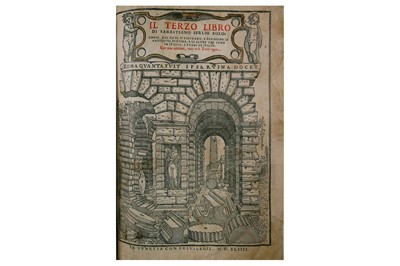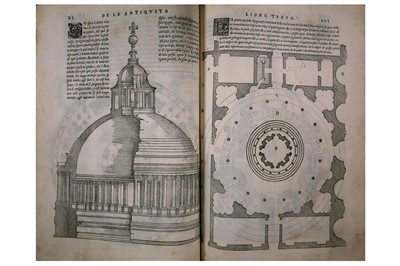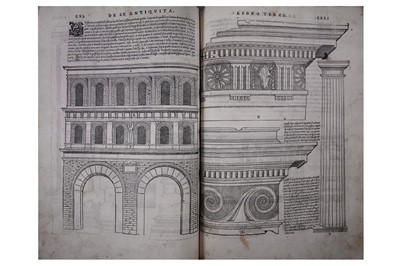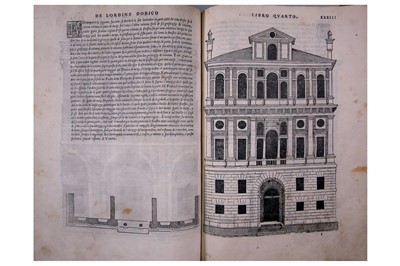2nd Dec, 2020 10:00
Books & Works on Paper | Live Online
Architecture.- Serlio (Sebastiano)
Architecture.- Serlio (Sebastiano)
Il Terzo libro… nel quale si figurano, e descrivono le antiquita di Roma, e le altre che sono in Italia, e fuori de Italia. Con nuove additioni…, second edition, [bound with] Regole generali di architettura… sopra le cinque maniere degli edifici, cioe, thoscano, dorico, ionico, corinthio, e composito, con gli essempi de l’antiquita, che per la maggior parte concordano con la dottrina di Vitruvio, third edition, woodcut architectural frontispieces, title in black and red, (first restored to margins), woodcut devices of Marcolini withing strapwork frame on last versos, extensively illustrated throughout with woodcut architectural illustrations, some light browning, occasional light staining or marking, , early signature to front free endpaper, occasional marginalia, contemporary vellum boards, later endpapers, some staining, folio, [Francesco Marcolini], Venice, 1544.
*** Second edition of ‘Il terzo libro’, published for the first time in 1540, just before Serlio left for France, and third edition of the ‘Regole generali’ (Book IV), which was the first of the famous ‘Sette libri dell’architettura’ to be published in 1537. Serlio (1475-1554) was first called in France by king Francis I to advise on the construction of the castle of Fontainebleau and was after named chief architect of the court. The first work, dedicated to king France I of France, is an anthology of the most beautiful ancient Roman and Italian antique buildings, completed with some of Bramante and Raphael’s major contemporary architectural edifices. The ancient edifices included in the book are typologically classified: temples and religious edifices (with the Tempietto of San Pietro in Montorio and the plans for St Peter’s Basilica in Rome), theatres, porticos, columns and obelisks, amphitheatres, bridges and thermal baths, triumphal arches; modern buildings (such as Bramante’s Belvedere palace, Raphael’s Villa Madama, Villa Poggio Reale near Naples). Serlio mostly provides direct information as he himself saw the Roman ruins, yet he does also use other first-hand sources.
(Quantity:1)
Do you have an item similar to the item above? If so please click the link below to request a free online valuation through our website.





